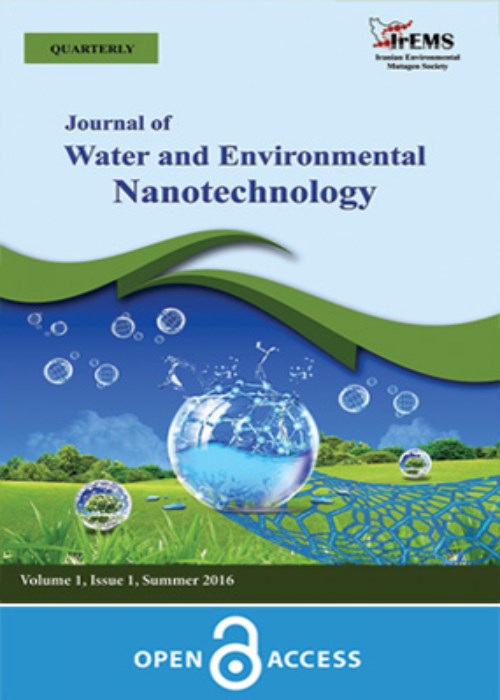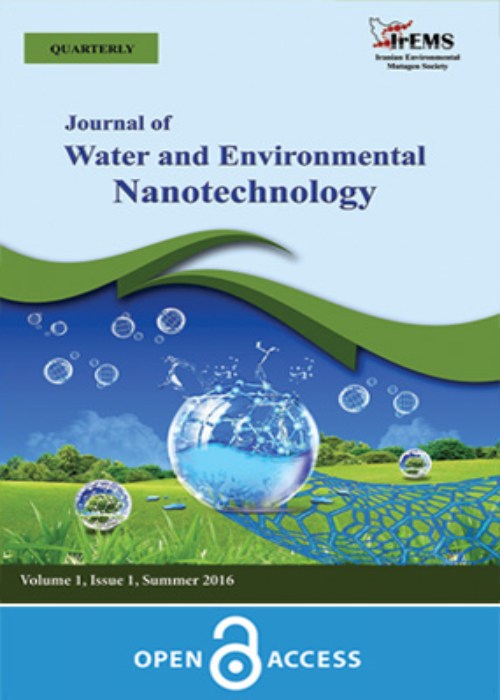فهرست مطالب

Journal of Water and Environmental Nanotechnology
Volume:8 Issue: 3, Summer 2023
- تاریخ انتشار: 1402/05/10
- تعداد عناوین: 8
-
-
Pages 206-214Water pollution by organic pollutants is an ever increasing problem for the global concern. The present study is aimed at synthesizing Titanium di oxide nanoparticles under two different concentrations of Zinc as dopant material. The synthesized nanoparticles are used as a catalyst in degrading malachite green dye an organic pollutant. The morphological studies of zinc doped Titanium di Oxide nanoparticles were carried out using different spectroscopic and microscopic tools. From the XRD Spectra average crystallite size, lattice parameters, volume of unit cell are studied. The bandgap of the material was found by using UV-Vis absorbance Spectroscopy. Fourier Transform Infrared Spectroscopy confirms the functional group present in the sample. Under light illumination, metal oxide nanoparticles act as a good photocatalyst in converting a harmful material into a less harmful one. In this aspect the malachite green dye prepared from river water is degraded under the illumination of visible light. Almost above 95% of degradation in 60 min is observed reporting the Zinc doped Titanium dioxide as an eminent photocatalyst.Keywords: Zinc, Titanium di Oxide, Photocatalysis, Malachite green dye, Concentration
-
Pages 215-228Dye-containing wastewater is a major pollutant that can irreversibly damage the environment. Ultrafiltration membrane technology combined with photocatalysis is used for treatment of dye-containing solutions. To remove dye pollution, Methylene blue (MB) and Congo red (CR), graphitic carbon nitride (CNG) and its zirconium dioxide nanocomposite (CNGZ) were used in the photocatalytic dynamic membrane system in both self-forming and pre-coated modes under household LED light. The filtration results of the self-forming membrane showed that the pure CNG- and nanocomposite-based photocatalytic membrane systems were more efficient for MB and CR dyes removal than the photocatalytic system in batch mode. In addition to improving dye molecule removal efficiency, adding the photocatalyst to the PES membrane also significantly increased water flux. Moreover, the respective MB and CR rejection rates were 29% and 47% for the pure PES membrane and 89% in 120 min and 100% in 80 min for the CNGZ-based photocatalytic membrane. This suggests that the photocatalytic membrane system is a more effective dye pollution remover than the pure PES. For comparison, the pre-coated dynamic membrane system used for MB dye removal was good for removing 98.6% within 20 min. The results suggest that CNGZ-based photocatalytic dynamic membrane is a promising technology for increasing dye molecules removal efficiency and flux in remediation of dye-containing wastewater.Keywords: Dynamic membrane, Photocatalysis, Decolorization, Graphitic carbon nitride, Household LED irradiation
-
Pages 229-240The green fabricated photocatalyst is promising material and could be applied for waste-water remediation and other ecological applications.Hibiscus floral extract surface modified Ni doped ZnO (HFNZO) was obtained by simple co-precipitation. The flowers have secondary metabolites such as phenolic compounds named as flavonoids; tannins are turned to be the reluctant to synthesize Ni/ZNO nanoparticles from the precursor. The prepared nanoparticles were examined by various characterization for their optical, structural and surface morphology properties was determined using Uv-Drs, FTIR, XRD, SEM, TEM, EDX, and XPStechniques. Absorption spectral shift of visible light region (red shift) and band gap reduction for ZnO (ZO), hibiscus modified ZnO (HFZO) and hibiscus surface modified Ni doped ZnO (HFNZO) properties were studied and shows a reduction in band gap of the nanoparticles from 3.0eV – 1.65 eV. Results obtained from XRD analysis shows that the synthesized HFNZO nanoparticles has a particle size of about 24.85 nm which is also confirmed by TEM analysis. A 98% visible-light-mediated degradation of the aqueous Rose aniline hydrochloride (RA) of 20 µM solution containing HFNZO of 0.05 g/L nanoparticles has achieved within 90 min. It follows pseudo first order Kinetic and the mechanism of generation of hydroxyl group due to flower extract surface modification and doping has been explained.Keywords: Hibiscus rosasinesis, Doping, HFNZO, Photocatalysis, Roseaniline
-
Pages 241-253This study aims to determine the effectiveness of the GO- Fe3O4/Psf membrane in filtering water contaminated with dyes and salt. The membrane was prepared using the phase inversion method, with variations in the composition of GO- Fe3O4 (0.25%, 0.50%, 0.75%, and 1.00%), with polysulfone as the polymer material and NMP as a diluent. The dead-end filtration method is used to study the ability to repel dyes and salt molecules in water. Hydrophilicity (surface contact angle test) and morphology (SEM) to confirm the membrane profile. Furthermore, rejection and filtration performance tests were carried out on water contaminated with dye (methylene blue) and water containing salt through salt rejection, flow flux, and UV-VIS tests. The filtration test results showed that the membrane with a composition of 0.75% had a salt rejection percentage of 59.33% (the highest), and the lowest flow flux was 54.42 L.m-2.h-1. The dye filtering results (MB) showed better performance on the same membrane. It has been observed that the permeate is brighter than the other membranes. These results indicate that the membrane with a GO- Fe3O4 concentration of 0.75 wt.% is the most effective compared to other membranes in filtering water. The presence of Fe3O4 nanoparticles increases the efficiency and durability of graphene membranes in salt rejection by increasing the surface charge and selectively adsorbing salt ions.Keywords: Graphene, GO-Fe3O4, Psf, Filtration, Membrane, Desalination
-
Pages 254-266In the recent decades, increasing of pollutant in water resources endanger the human life and other living things. Researchers have applied different methods to eliminate the water contaminants. Photocatalytic is one of these methods that have been used widely for wastewater treatment. In this study, a series of Mn, Fe, Co, Ni, and Cu doped ZnO nanorods were applied as visible-light-activated catalysts for oxytetracycline (OTC) degradation. Characterization of the nanorods was performed using XRD, FE-SEM, UV-Vis, and PL techniques. The results show that photocatalytic activity of the samples highly depends on morphology, size and band gap energy. The UV–Vis spectroscopy indicate that Fe doping has reduced the band gap energy to 2.91 eV. The variation of band gap permits absorption of low energy photons and excitation of valence band electrons. The photoluminescence spectra reveal that doping has an effective role in inhibiting the recombination of electron/hole pairs during photocatalytic process. The Mn-doped sample exhibits significantly increased photocatalytic activity and greater degradation rate constant (k) in comparison with the pure ZnO.Keywords: Zinc oxide, Nanorods, Transition Metal Doping, Photocatalytic degradation, oxytetracycline
-
Pages 267-284In the current study, 25% incorporating PVT hybrid CPC collector double slope solar still is using Al2O3 nanoparticles underwent energy matrices analysis and life cycle conversion efficiency (LCCE). With the aid of an analytical programfed into MATLAB, the analysis is conducted on an annual basis based on the atmospheric conditions in New Delhi. The IMD in Pune, India, provided the input data needed for the numerical computations. The average annual energy output will be calculated using energy and exergy, then evaluated. This will reveal that the average annual yield is 8.5%, the average energy payback time is 16.16%, the average energy payback factor is 13.91%, and the average life cycle cost conversion efficiency is 7.15% higher. Therefore it is obvious the proposed system is better on the basis of following parameters i.e. annual yield, energy matrices such as efficiency of life cycle cost (LCCE), factor of energy payback (EPF), energy payback time (EPT) than previous system. The proposed hybrid system can be met the future requirement of potable water as well as electricity.Keywords: Energy matrices, Energy Payback Time, Energy Production Factor, life cycle conversion efficiency, Al2O3nanoparticles
-
Pages 285-292In this current research work, the synthesis of Copper (Cu) doped and Magnesium (Mg) co-doped of BeFiO3 (BFO), i.e BiFe1-xCuxO3 (where; X= 0.1, 0.15 and 0.2 wt.%) and Bi1-yMgyFe1-xCuxO3 (where; Y=0.05, 0.1 and 0.15 wt.%) were prepared by sol-gel method. The obtained samples were analyzed by various characterization techniques including X-ray diffraction (XRD), surface morphology examined by field emission scanning electron microscopy (FE-SEM) and transition electron microscopy (TEM). It was noted that Cu (0.15 wt.%) doped BFO had notable photocatalytic activity for Rhodamine (RhB) dye degradation when exposed to visible light irradiation. In addition to Cu (0.15 wt.%) by adding Mg (0.1 wt.% ) as a co-doping, exhibited higher photodegradation than the pure BFO, Cu-doped BFO (0.1and 0.2 wt.%) and Mg co-doped BFO (0.05 and 0.15 wt.%). Here we reported a new driven photocatalyst by doping of Cu and co-doping of Mg into BFO simultaneously. These played a key role in hampering the recombination of electron-hole pairs hence chance to increase dye degradation performance. These findings could be useful for developing affordable photocatalysts for wastewater purification.Keywords: BFO, Sol-gel Method, Rhodamine dye
-
Pages 293-319
Conventional food packaging materials such as plastic or other petro-based polymers provide the necessary strength and barrier qualities, but they are associated with economic and environmental associated hazards. In order to have a material that can effectively compete with petroleum-based plastics, the ecofriendly biodegradable biopolymer reinforced bio-nanocomposites from renewable agricultural biomass can be a promising alternative. Lignocellulosic biomass from agricultural wastes can serve as promising raw material for nanocellulose extraction. This review focuses on extensive studies done on pretreatment, isolation of nanocellulose along with their role as reinforcement agent in various biopolymers such as poly-lactic acid, starch, chitosan, alginate and carrageenan. The uniqueness of this review is to give readers a thorough overview of the impact of nanocellulose on the mechanical, barrier, and thermal properties of biopolymeric film. The review will also provide a comprehensive understanding of the supply chain’s elements, their opportunity and constraints for shifting the sustainable production system of cellulose nanocomposites towards circular economy. Efforts have also been made to combine all the recent studies related to key aspects and engineering of nanocellulose biocomposites. The concept of 3D/4D printing technology of cellulose nanocomposites in conjunction with Shape Memory Polymers (SMP) in the domain of commercial development of smart materials and self- folded packages for food applications has also been discussed.
Keywords: Biodegradability, Food Packaging, Nanocellulose, Nanocomposites, 3D, 4D printing


